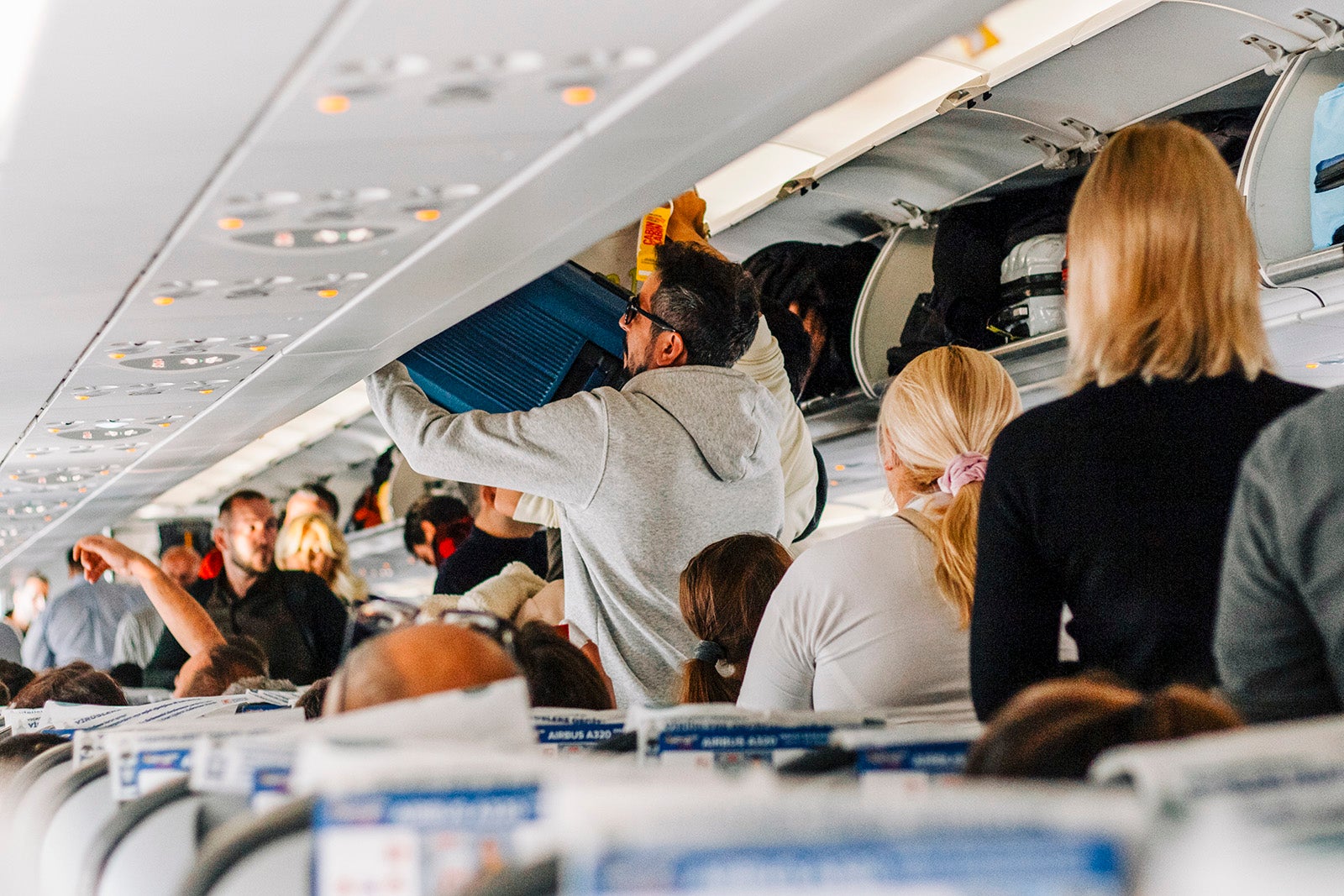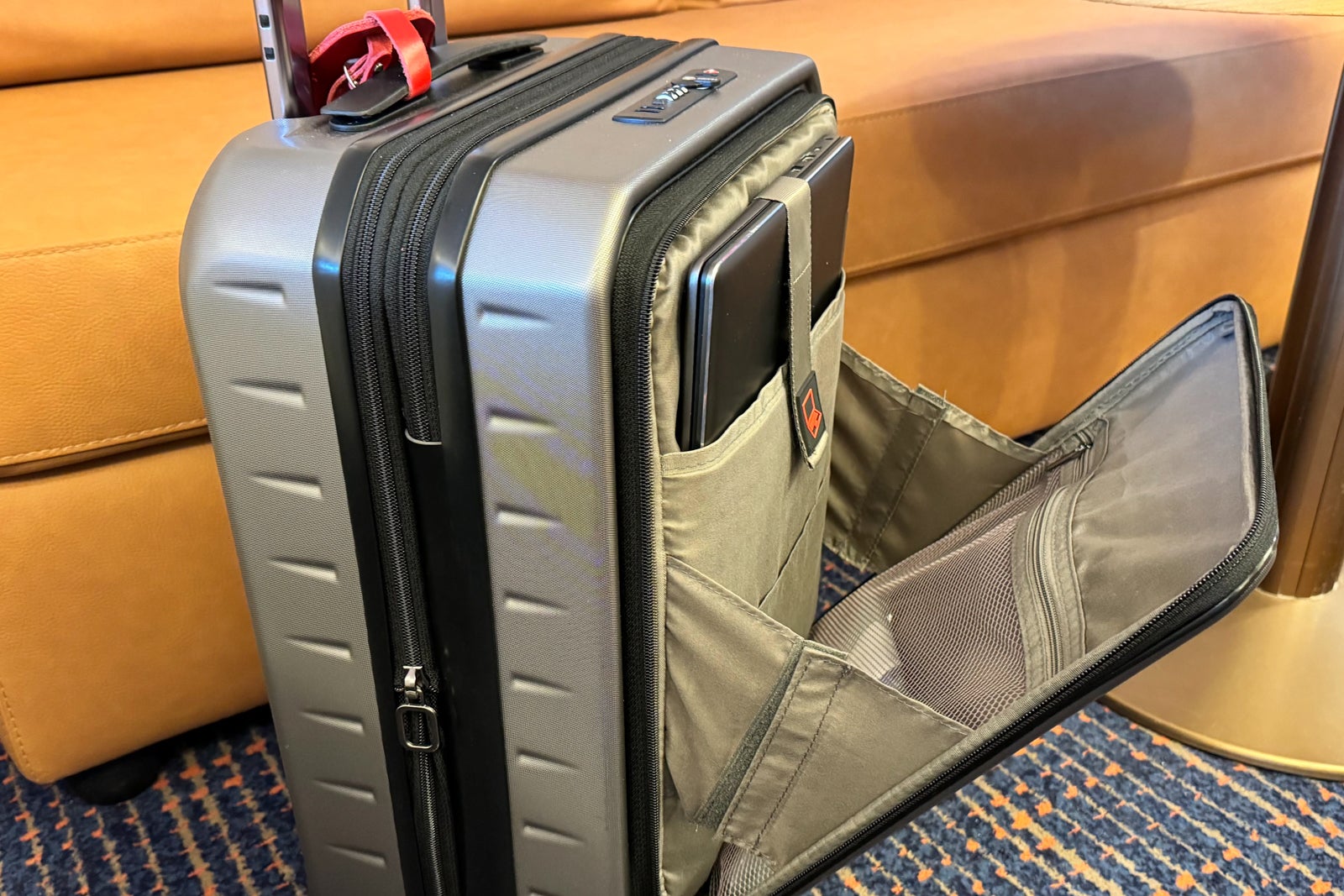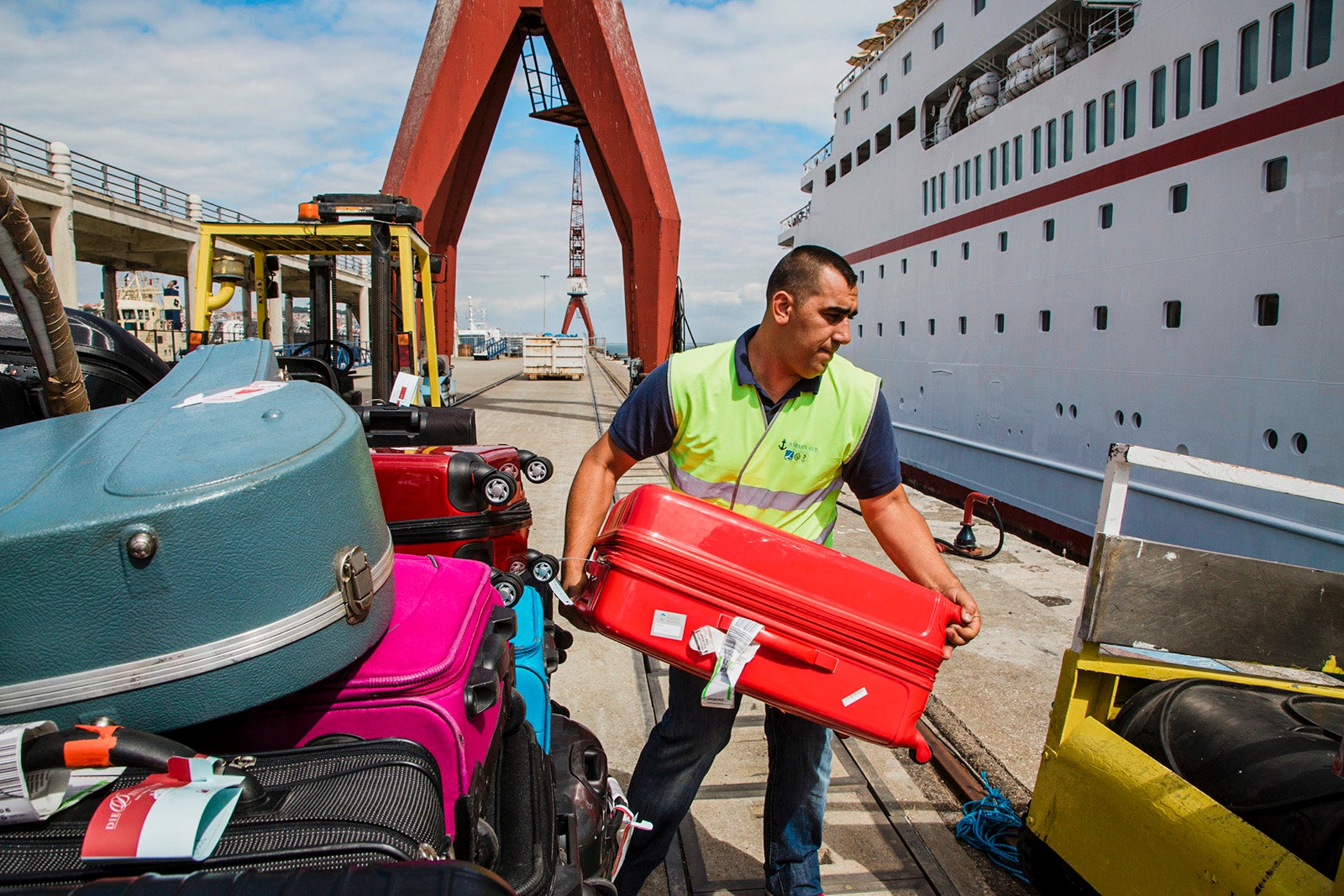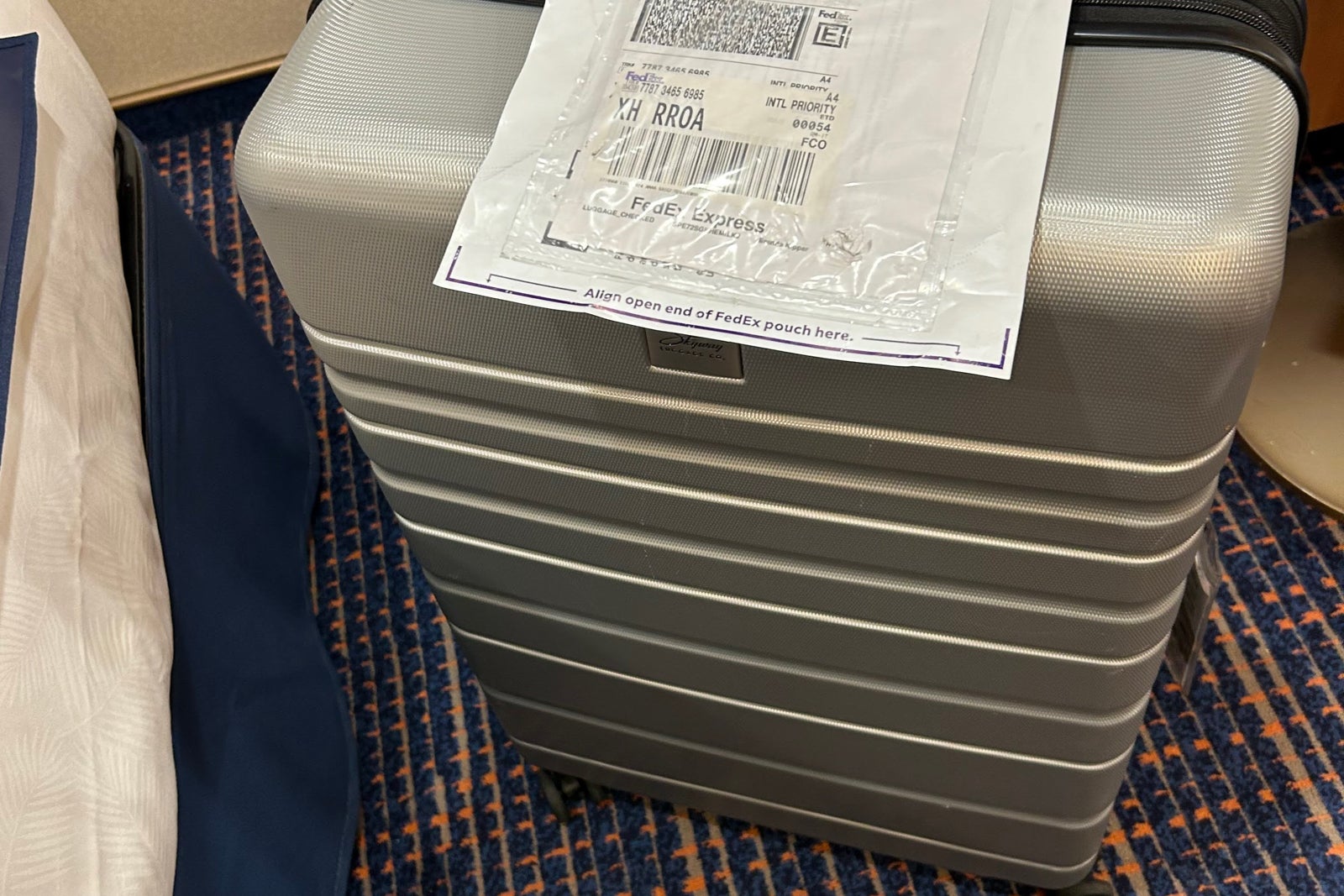Checking your cruise luggage with an airline can be a scary proposition, especially when you factor in possible weather delays or missed connections that can separate you from your bags. The farther you have to fly, the scarier it becomes.
But what are your options? The obvious choice for most cruisers who fly to their embarkation port is flying with only carry-on luggage. Easy enough for a short cruise in the Bahamas or Caribbean where clothes are skimpier and cruises relatively short. But what about a cooler climate cruise or a longer sailing?
I recently faced a perfect storm of potential checked luggage issues for flights to a transatlantic cruise on a Carnival Cruise Line ship — unpredictable fall weather, a domestic connection involving an airline change, followed by a pair of European flights with a tight connection in an unfamiliar airport. That schedule left this firmly entrenched bag checker considering carry-on only on a long cruise for the first time.
When my aunt decided to join my husband and me on the cruise, the challenge rose to a new level. We’d be managing our bags and assisting her, which could be overwhelming.
Upon reflection, we decided that shipping luggage to the cruise seemed like a far better choice for her. She would still need a carry-on bag for our two nights precruise in Rome, but she could send a 50-pound bag directly to the cruise ship and have everything she needed waiting for her when we arrived.
Now we had the perfect opportunity to test these two luggage options head-to-head. Which plan was easier? Which one cost less? What were the pitfalls of each option? Read on for our results as you decide how light to pack and how best to get your bags to your cruise ship without incident.
Carry-on-only cruising: Costs and inconveniences

The first thing to consider when flying with carry-on bags is the maximum dimensions and weight of luggage allowed on the plane with you. While few domestic carriers have weight restrictions on carry-on luggage or personal items, regional, low-cost and non-U.S. carriers can have weight allowances on both.
The standard carry-on size for domestic flights within the U.S. is 22 x 14 x 9 inches. Personal items (purses, tote bags, backpacks, briefcases and other small items stowed beneath the seat in front of you) are often capped around 18 x 14 x 8 inches.
Foreign carriers are far pickier about what you bring on board the aircraft. Expect similar carry-on luggage dimensions of 21.5 x 15 x 9.5 inches. Maximum personal item sizes can be as small as 15.5 x 11 x 4 inches — which is compact for a backpack. Weight limits vary by air carrier and even by seating class; our carry-on suitcases needed to have a maximum weight of 26 pounds and our backpacks could not weight more than 4.4 pounds.
Related: How to cruise with just a carry-on
All those restrictions sent me shopping. My husband had a hard-side spinner that met our specific airline restrictions, but I did not. The backpack and assorted tote bags I normally use as personal items were all too large. The camera backpack my husband normally uses was too small to be a useful personal item on a trip when every inch of space was needed for items more important than camera lenses. I would also need more packing cubes, so I could compress my belongings and pack the most clothes into such small spaces.
After three Amazon exchanges, I finally found a backpack that met the airline size restrictions and my personal requirements: a trolley strap, a water-bottle side pocket, a front-opening main compartment, a padded laptop compartment and several small outside pockets. (Beware that the online listings aren’t always accurate regarding bag dimensions.)
I spent $79 total for two backpacks. The best feature during actual use was a vented bottom-opening zipper compartment intended for shoes, which was ideal for stashing our quart bags containing TSA-approved liquid products. That easy access was invaluable during our fast dash through the Warsaw airport security line on our tight connection.
For a carry-on spinner, I had a strong desire to have a front fold-out compartment for electronics. I also wanted an expansion zipper, which couldn’t be used on our flights to Europe, but would come in handy for squeezing in the two bottles of wine we were allowed to bring on board our cruise. Once back in the U.S., our flights home on Southwest had no weight restrictions and larger size restrictions of 24 x 16 x10 inches, so the expansion zipper meant we could bring back a few small souvenirs and one bottle of wine.

You can spend a lot on carry-on bags, but I opted for an $89 knockoff on Amazon that had fabulous features that made it far more useful on the trip than I had expected. For example, the front electronics panel provides access to the inside contents of the suitcase, essentially making it a front-opening piece of luggage when there’s no space for the typical open-book layout of most hard-shell spinners. That proved to be critical in our tiny hotel room in Rome’s historic city center.
For compression packing cubes, I opted for a six-piece set from COR Surf that gave us maximum space savings for only $23. I squeezed a raincoat and a jacket into each of the two medium bags, five men’s shirts into one large bag and eight of my shirts into another.
For years, we’ve been happily cruising with our cosmetics, hair supplies and first-aid supplies packed in half of a cheap hanging shoe bag we attach to the stateroom wall with magnets. It was too large for our carry-on luggage, so I replaced it with two medium-sized travel toiletry bags with four compartments that unfold and hang from a hook. Again, Amazon to the rescue for $12 each.
Related: 12 items you should always pack in your cruise carry-on bag
Traveling with carry-ons only, I also could not bring full-size toiletries. Our local drugstore sells a variety of empty small bottles and jars for carrying liquids like hair products, creams and gels. I spent $7 on an assortment of those.
The total I spent on new items needed to make flying to our cruise with only carry-on luggage work was $203, but it would be easy to spend twice that. I don’t feel like I skimped on quality, and all items I bought should have a useful life in my cruise packing arsenal going forward. If you already have these items, your out-of-pocket cost will be far less.
With the airline weight restrictions, it was impossible to pack 18 days’ worth of clothing in two carry-on suitcases and two backpacks. We had to pare down our wardrobe to only the essentials and plan to do laundry on board.

I’m a rather small person, wear size 8 shoes and have been traveling with a compartment-style wardrobe of coordinating colors since before there was a trendy name for that. Even still, getting the basics pared down was a challenge.
It did not help that weather on a transatlantic cruise can be quite variable, which forced me to pack layers I wouldn’t have needed on a warm-weather cruise. Things I missed were a sweatshirt for chilly days at sea, one more pair of casual pants (I took three, two of which converted to shorts) and more than one hat.
At least our Carnival ship had a self-serve launderette. The machines were full-size with a cost of $3.50 per wash or dry. A box of laundry detergent large enough for two loads was another $2. (Next time we’ll bring laundry detergent sheets.)
Self-serve laundry once during a cruise isn’t a big deal, but needing to do laundry twice took away a little of the vacation relaxation, especially when the line to use the laundry facilities was long and full of cranky cruisers.
Many ships do not have this self-serve option, offering send-out laundry service only with costs ranging from per-piece pricing of $3 to $7 to discounted bulk by-the-bag prices or by-the-day packages. Our total cost for laundry was $16 for two loads, but on a similar cruise without self-service facilities or discounted packages, you could potentially spend hundreds in laundry fees.
Airline weight restrictions also forced us to leave behind a few nonclothing items we then had to buy along the way. These included extra hair spray and toothpaste, a room deodorizer and a corkscrew for our cabin. We easily found a corkscrew for 4.30 euros ($4.54) and a gel room deodorizer for 2.20 euros ($2.35) in a market only two blocks from our hotel in Rome. The store also had a fair selection of wine, so we snagged a couple of bottles to take on board, each in the six-euro range, considerably less than a cruise ship bottle.
We had enough toothpaste and hair spray to last a few days, so we waited to go shopping for toiletries until Cartagena, Spain. Finding a supermarket there required a bit of a walk, but we bought toothpaste and hairspray (5.76 euros and 3.49 euros, respectively, or $6.10 and $3.70), along with some Oreo-flavored Coke Zero. As much as I enjoy port shopping, the need to spend time looking for essentials like hair spray was a definite inconvenience when cities like Rome and Cartagena had so many amazing ways to spend our limited time.
Luggage shipping: Costs and inconveniences

We used a complimentary voucher from Ship and Play for my aunt’s luggage to test the service for this story. The cost to ship a full-size 50-pound suitcase one-way from her home in Texas to our cruise ship in Civitavecchia, Italy, was quoted as $244.99 for the shipment, plus a fee of $74.97. She added $2,000 in insurance for $22.99, making the total $342.95.
Because shipping directly to a cruise ship requires the address of the ship’s courier in the departure port, the shipping order had to be completed with a Ship and Play agent on the phone. That went smoothly, with the agent providing all necessary instructions, both verbally and via a follow-up email. The shipping label, customs forms and stick-on pocket for the label were sent via mail.
A FedEx tracking number was provided, but my aunt opted to place a tracking device in the bag as well, adding $24 to her cost, for a total of $366.95. If you’re a member of Clear, you can get 50% off your first shipment with partner company Ship and Play.
Shipping luggage internationally is pricier than it would be to a domestic embarkation port. A quick check of various cross-country prices to U.S. cruise ports showed base shipping rates (before the fees and insurance) of $74.99 on Ship and Play and prices starting at $99 on competing shipper Luggage Forward.
Related: 26 cruise packing hacks you need to know before you sail
The number one inconvenience in shipping luggage is planning for the shipment. It is not a last-minute option. You have to allow enough time to receive the shipping label and packet from your preferred shipper, to arrange for the pickup (or drop-off) and for the luggage to travel to its destination.
When your cruise departure port is international, the luggage ship date must also allow enough time for the bag to clear customs once it reaches the country of departure. Ship and Play calculated all those variables and then gave my aunt options for her pickup date, which were a full two weeks before the cruise. Her quoted price included selecting the day FedEx would pick up the luggage, but not a narrower time frame on that day. Selecting a two-hour window was available for an extra charge. She could also have opted to drop off the luggage at an authorized shipper at no charge.

My aunt said packing her main luggage two weeks before her cruise was a bit challenging. That’s too far out to predict the weather, so she had to prepare for all possibilities with layers and a rain poncho (that she never used).
She also opted to send her large bag directly to our ship instead of to our precruise hotel. That meant she still had to take a carry-on and a tote bag for clothing and things she needed for the days we spent in Rome before the cruise. She said she had a hard time deciding which items to pack in each bag and found herself overthinking the process.
Related: Cruise packing list: The ultimate guide to what to pack for a cruise
If she had chosen to ship the bag to our hotel in Rome, she could have skipped the carry-on, but we would have had the inconvenience of dealing with the large bag at our small hotel and on our trip to the ship.
Ultimately, my aunt’s bag arrived in her cabin on the ship around 4 p.m. without her having to wrangle it into and out of multiple vehicles during the trip. After she packed her bag and handed it off to FedEx at her front door, she didn’t have to lift a finger until it came time to unpack it on board — which added a touch of luxury to her mainstream cruise.
Bottom line
Choosing to skip the bag check line all together is becoming a popular choice among cruisers, and not only because you can save on checked-bag fees and tips to porters. I have met fellow passengers with lost luggage on every cruise I’ve been on in the last four years. Losing your luggage on dry land is a problem, but a minor inconvenience when compared to being stuck on a cruise ship without your stuff.
The more complicated your flights are, the greater the chances for lost or delayed luggage. Traveling with only carry-on luggage or shipping luggage to your ship are both good alternatives. Which one you choose depends on your travel scenario.
We found that both options come with costs and minor inconveniences. Carry-on travel costs less but you’ll have to leave some desired items behind and take time out to do laundry during your vacation (or pay inflated rates to have someone else wash your clothes). Shipping luggage is the more expensive option, but you can pack full-size bags, have them picked up at your front door and not touch them again until they arrive at your cruise cabin.
No solution is perfect, but knowing the pros and cons of each option will help you make the right decision for your travel party on your next cruise.
Planning a cruise? Start with these stories:
- The 5 most desirable cabin locations on any cruise ship
- A beginners guide to picking a cruise line
- The 8 worst cabin locations on any cruise ship
- A quick guide to the most popular cruise lines
- 21 tips and tricks that will make your cruise go smoothly
- 15 ways cruisers waste money
- The ultimate guide to choosing a cruise ship cabin



